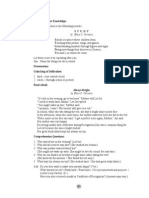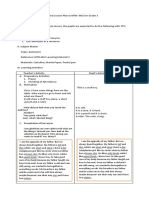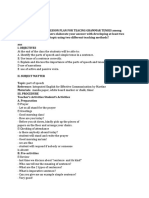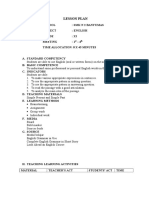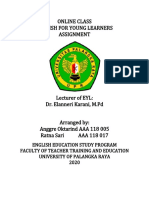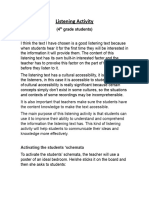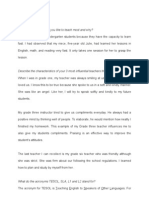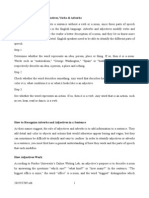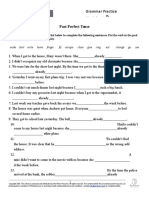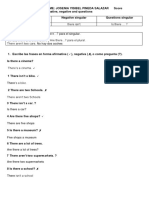Step by Step With Functional Grammar
Step by Step With Functional Grammar
Uploaded by
api-269356182Copyright:
Available Formats
Step by Step With Functional Grammar
Step by Step With Functional Grammar
Uploaded by
api-269356182Original Title
Copyright
Available Formats
Share this document
Did you find this document useful?
Is this content inappropriate?
Copyright:
Available Formats
Step by Step With Functional Grammar
Step by Step With Functional Grammar
Uploaded by
api-269356182Copyright:
Available Formats
Step-by-Step with functional Gammar.
doc
Page 1 of 11
STEP-BY-STEP WITH FUNCTIONAL GRAMMAR
Fiona Kettle-Muspratt
Fiona is a peripatetic ESL teacher in the Gold Coast region of the state of
Queensland in Australia. She works with all levels of ESL students (new arrivals
through to extension) from Year 1-7 in groups from 4 to 10.
Tim is a 12-year-old ESL student. Here are three texts which follow his writing development.
The texts are in response to the following visual and the text underneath it.
Mr Bates was eating his dinner when the phone rang. He put his dinner on the chair and
talked on the phone. When he finished, he sat on his dinner.
Text 1: September
(no support was provided)
Mr bates was eating the food and then hear the phone is ringing. Then he put his
food on the chair and get the phone, talk to his friend. Finally, when his finish he
went back, but when he sit on the chair, he forgot the food, but its too late so he
cant eat his food now.
Text 2: November, 7 weeks later
(no teacher support was provided in writing this but the use of a thesaurus was encouraged)
Mr Bates who is a forgetful man was eating his delicious dinner on a comfortable
chair, then the telephone is ringing very noisily. Then he quickly get up and put his
lovely dinner on the chair and meander there and converse to his friend, and then
his friend admitted Lets go play basketball tomorrow. Mr Bates was very joyful,
and yelled to his friend Okay, thats cool, and put the telephone back, but when
he went back, set on the chair, he forgot the food was on the chair, but it was too
late, so now he cant eat his delicious dinner.
Text 3: November, 8 weeks later
(support was provided; including word banks and scaffolding through joint construction)
Like a clam at high tide, Mr Bates was eating his extremely delicious dinner while
sitting on his comfortable chair. Suddenly the incredibly noisy phone rang so he
quickly put his delicious food on the chair and rushed to answer it. He chatted with
his best friend who suggested, Lets go camping tomorrow. Mr Bates was
overjoyed and screamed, Thats so cool! Okay, Ill see you tomorrow, and hung
up. He then went back to sit on his chair, but because he had a mind like a sieve,
he forgot his food was there! It was too late, and then he yelled, Now I cant eat
my lovely dinner!
Step-by-Step with functional Gammar.doc
Page 2 of 11
How did the student develop the linguistic tools needed to be able to write a text that is so much
more advanced after only eight weeks?
This article outlines the kinds of activities the class teacher undertook with the above student
and with all her students. It is written as if she were recounting the steps taken, and the
worksheets and language examples used.
Support was provided by the teacher by developing with the students a range of linguistic
resources from a functional perspective. The focus was on elements related to developing the
field such as processes, participants and circumstances and then more specifically nominal
groups.
Working with the students
As an introduction to functional grammar, I tell the students that we are going to look at a fun
way of turning boring writing into super writing and we are going to use three colours
(green, red and blue) to help us. Across the top of my whiteboard I have a permanent display of
the functional questions that are concerned with transitivity: processes, participants and
circumstances.
Jane is dancing gracefully Fred swims every day Tom is surfing at Burleigh Heads
A typical discussion surrounding this display might be:
Teacher: What can you tell me about the green words?
Student: They tell us what the actions are. (They might also use expressions such as the
doing words or the action words or the verbs.)
What are we
doing here?
(eg running,
cooking, falling)
What is going
on here?
(eg barking,
burning, yelling)
Who ?
(eg is running,
yelled, is going
to cook)
What ?
(eg is barking,
burned, is going
to fall)
When ?
(are we doing
it?: tomorrow, in
the morning, on
Monday
How ?
(are we doing
it?: gracefully,
slowly, softly,
Why ?
(are we doing
it?: for health
reasons, for
money
Where ?
(are we doing
it?: at the beach,
on the oval, in
the playground)
Who with ?
(are we doing it
with?: with my
family, instead of
me, with Kona
Who?
(participant)
Whats happening?
(process)
How?
(circumstance)
Who?
(participant)
Whats happening?
(process)
When?
(circumstance)
Who?
(participant)
Whats happening?
(process)
Where?
(circumstance)
Step-by-Step with functional Gammar.doc
Page 3 of 11
Teacher: Thats right, these words tell us what is happening or what is going on in the
sentence (I am drawing their attention to the display charts above the board.)
Teacher: What can you tell me about the red words?
Student: They are the people (or the things some might even say that they are nouns).
Teacher: Yes, these words tell us who or what is dancing (or whatever the action is.)
Teacher: What can you tell me about the blue words?
Students: (By now, they are using the charts to help them answer.) They tell us where Dan
surfs. (Other possible examples are when Dan swims or how Grace dances or why
Dan runs.)
Next, I present the students with a series of sentences and a green, red and blue pencil. Some
sample sentences are:
My mum is eating apples.
My dog sleeps on a blanket.
Jane is singing a lovely song.
Yesterday, I went to the beach.
At my Nans house, I have a fishing rod.
We work through the sentences one by one in the following way:
Teacher: In sentence 1, whats going on? Whats my mum doing?
Student: Shes eating
Teacher: Yes, so what colour do we underline it?
Student: Green.
Teacher: Why is it green?
Student: Because shes eating; that is what shes doing.
Teacher: Who is eating?
Student: My mum.
Teacher: Yes, so what colour do we underline that?
Student: Red.
Teacher: Yes, why?
Student: Because my mum tells us who is eating the apples.
Teacher: So my mum is eating what?
Student: Apples.
Teacher: And what colour do we underline apples?
Student: Red, because apples tells us what mum is eating.
I usually work through about 20 of these sentences in the Writing in Colours worksheet and,
by this point, the students are ready to start creating some of their own.
WORKSHEET
Writing in colours
My mum is eating apples.
My friend plays tennis
Tom surfs at Surfers Paradise.
I live with Jane.
Jane is singing a lovely song.
The baby is crying loudly.
The baby is sucking his toy.
My sister drives a sports car.
I want a red dress.
Sometimes I go to Brisbane.
Step-by-Step with functional Gammar.doc
Page 4 of 11
At my Nans house, I have a fishing rod.
I eat slowly.
Mum drives to work.
Dan runs for health reasons.
Jan swims every day.
Yesterday, I went to the beach.
My dog sleeps on a blanket.
Dad paints on weekends.
She picked a flower.
The boy climbed a tree.
Slowly the cat walked into the house.
I read a book last week.
The teacher called the boy.
With the Writing in Colours sheet to refer to if needed, students write their own sentence
examples to set patterns as set out in the worksheet. To start this writing activity off, I create a
word bank of processes, participants and circumstances.
WORKSHEET
Writing in coloursnow its your turn
red, green red
red, green, blue
blue, red, green, red
blue, red, green, blue
Step-by-Step with functional Gammar.doc
Page 5 of 11
Expanding sentences
Following the Writing in colours: now its your turn activity, students are generally ready to
start expanding a sentence on their own. While the focus is initially on describers, adding
qualifiers (initially expressed as adding a group of words) is also incorporated into the same
lesson. So, by the end of this lesson, students have expanded the nominal group by placing
describers in front of the thing and a qualifier after it.
Students are presented with a sentence such as: The cat is chasing the dog.
Teacher: Whats going on here? What is happening?
Student: Chasing.
Teacher: (Underlines chasing in green.) The cat is chasing the dog.
Teacher: Who is chasing?
Student: The cat.
Teacher: (Underlines the cat in red.) The cat is chasing the dog.
Teacher: The cat is chasing what?
Student: The dog.
Teacher: (Underlines the dog in red so that the end result is: The cat is chasing the dog.) Is
this an interesting sentence?
A discussion follows about what makes writing interesting with the gist of this discussion being
that what makes writing interesting is a reader being able to picture what the cat and dog look
like through good descriptions.
Exploring describers
A word bank of describers is then created; first for the cat and then for the dog.
Teacher: Lets make this cat bad. Give me some describing words for this cat (mean, evil,
ugly, big, enormous, hungry, naughty).
Lets make the dog good. Give me some describing words for this dog (cute, fluffy,
happy, sweet, shy, little).
We then put a sentence together using these words: The enormous, ugly cat chased the cute,
fluffy dog.
Exploring qualifiers
The qualifiers (which, in the beginning, we call group of words) I start with for building the
field of cats are prepositional phrases beginning with with (with evil eyes, with sharp claws,
with dirty fur, with long whiskers).
Teacher: To make this sentence even more interesting lets think of a group of words to
further describe the cat.
Then we do the same for dogs.
Teacher: Lets think of a group of words to further describe the dog (with fluffy, white fur;
with enormous, brown eyes; with a diamond collar).
Step-by-Step with functional Gammar.doc
Page 6 of 11
In the lessons that follow, I introduce alternative prepositions (at, in, near, next to.) After
prepositional phrases as qualifiers have been worked with, we move on to clauses as qualifiers.
Next, we put a sentence together using the expanded describers and qualifiers, such as:
The enormous, ugly cat with evil eyes chased the cute, fluffy dog with a diamond collar.
More qualifiers
When students are ready, the examples of groups of words can be expanded to include options
besides with. To do this, I start with a list of prepositions and lead the students into
compiling other prepositional phrases.
Teacher: We dont have to start our groups of words with with. We could start with any of
these prepositions (showing the preposition chart).
Lets think of a group of words starting with at, (at the beach, at my nannas house,
at school), in (in the garden, in the box), under (under the house), near (near my
house), down (down the street).
At some point, depending on the level of English of the group, I explain that these groups of
words are called prepositional phrases.
Using circumstances
To conclude, I ask the students how we can add circumstances to sentences; often, we refer to
their visual representation, such as: Can we add some blue to this? Students continually refer
to the display above the whiteboard, which shows the functional groupings with their colours
and their questions.
Teacher: What could we say for when? (Last night, the other day, this morning, on the
weekend.) Where could we write that?
Generally, the students want to add the circumstances at the end, so the purpose of this is to
open them up to the idea that the blue group of words can also come at the front.
The class continues through the same questioning sequence for circumstances:
where: under our house, across the street, along the beach, around the pool
how: quickly, angrily, silently (In the early stages, circumstances of manner can be
difficult to elicit so, initially, I focus on when and where).
A few options are written up to conclude our joint construction:
The enormous, ugly cat with evil eyes chased the cute, fluffy dog with a diamond collar under
our house.
On the weekend, the enormous, ugly cat with evil eyes chased the cute, fluffy dog with a
diamond collar.
Last week, the enormous, ugly cat with evil eyes chased the cute, fluffy dog with a diamond
collar around our pool.
Step-by-Step with functional Gammar.doc
Page 7 of 11
Relative clauses as qualifiers
The next step is to return to the nominal group and explore relative clauses as qualifiers.
Teacher: Groups of words can also start with who, which, and that (whom and whose
come in later). We then brainstorm clauses starting with each of these: who (who
lives next door), which (which has a long tail, which was playing on the beach),
that (that has a diamond collar, that was barking all night).
The feral cat with sharp teeth and claws chased the fluffy white puppy that was wearing a
diamond collar into the huge house with magnificent gardens // and knocked over all of the
golden statues.
ESL students
I have found that while ESL students are able to create phrases and clauses quite easily
(provided they have developed the lexis), when they put it all together, they are inclined to write
examples such as: The cat with pointy ears he chased the dog. Although it is possible to say this
in English, it is highly marked and it is almost certain that students are choosing it because they
are transferring from their primary language, in which it is likely to be an unmarked choice. In
order to correct this, I get them to create sentences on a grid so they can clearly see that straight
after the group of words comes the green.
WORKSHEET
This grid concept can then be extended to expose the students to the range of functional groups
in the nominal group and to a range of examples.
Note that the other participants are more thabn likely to be nominal groups and the circumstances themselves can contain nominal groups so
whatever can be described and classified and quantified and qualified in the nominal gorup first
Pointer Describer Thing
Qualifier
group of words
Whats happening?
end of the sentence:
what, who
participant process participant
The pretty girl with long hair is holding her grandmas hand.
Pointer Describer Thing
Qualifier
group of words
Whats happening?
end of the sentence:
where, when, how, who with
participant process circumstance
A cute cat with blue eyes was sitting in the window.
Step-by-Step with functional Gammar.doc
Page 8 of 11
WORKSHEET
How things are done: circumstances of manner
Once students have some control of expanding the nominal groups, both as the participants and
in the prepositional phrases that function as circumstances, I switch the focus to circumstances
of manner initially those realised by adverbs ending in ly.
Using a selection of simple action pictures, I ask the students to describe how the person is
performing the action.
Teacher: How is the bear eating the berries?
Students: Quickly, hungrily, messily, silently.
Teacher: How are the children playing?
Students: Happily, loudly, energetically, quietly, excitedly.
Teacher: How did the turtle cross the road?
Students: Slowly, carefully, anxiously, nervously.
After going through sufficient pictures to create a word bank of these circumstances of manner,
I then demonstrate how the they can move around in sentences because we often need them to
be close to the action.
Teacher: Give me a sentence about the children using happily.
Student: The children played a game happily.
Teacher: (Writes this on the board and continues asking the functional questions and
underlining or highlighting and ends up with The children played a game happily.)
Whats going on? (played) Who played? (the children) Played what? (a game).
Teacher: What colour is happily?
Student: Blue.
Teacher: Why?
Student: Because this is how the children played.
Teacher: (Teacher underlines happily in blue: The children played a game happily.) Can we
place happily anywhere else in the sentence? (The class discusses the options and
writes each one on the board:
The children happily played a game.
The children played a game happily.
Pointer
Counter
(How many?)
Intensifier
Describer
(Whats it like?)
Classifier
(What type?)
Thing
Qualifier
(Which one in particular?)
Whats
happening?
end of the sentence:
what, who
participant process participant
The incredibly black guide dog near the ferris wheel was eating fairy floss.
Pointer
Counter
(How many?)
Intensifier
Describer
(Whats it like?)
Classifier
(What type?)
Thing
Qualifier
(Which one in particular?)
Whats
happening?
end of the sentence:
where, when, how, with
who, with what
participant process circumstance
Several rather naughty boys in front of the clown stand pointed at the angry man.
Step-by-Step with functional Gammar.doc
Page 9 of 11
The lady drove home.
The lady drove home slowly.
Slowly the lady drove home.
The lady slowly drove home.
The lady drove slowly home.
An extension of this is to introduce similes (circumstances of manner (comparison)) and idioms
as an alternative to using a describer or circumstance of manner (means) in a sentence, for
example:
Happy/happily: as happy as a lark, on cloud nine, like a clam at high tide, in seventh heaven
Angry/angrily: about to blow a fuse, hot under the collar, like a wild animal, as mad as a
hornet
Sad/sadly: feeling blue, wearing a long face, like a piano without its key
Students are given opportunities to play with these, starting off with individual sentences and
then moving to short descriptive texts which I call mood writing. For example:
Tom walked home happily.
Tom walked home as happy as a lark.
As happy as a lark, Tom walked home.
Mood writing
Once students are underway expanding nominal groups and are comfortable using circumstance
of manner (means) in various sentence positions, I then introduce mood writing. I give
students 3 or 4 simple sentences such as:
Ben walked home.
He put his bag down.
He went to his room.
He sat on his bed.
Teacher: Is this interesting writing?
Student: No, its boring.
A discussion follows as to why this writing is boring and what needs to be added to make it
more interesting. Based on the students experiences to date, their responses typically state that
it needs some describers or qualifiers (groups of words) or circumstances of manner (means).
I then ask the students if they can tell what mood Ben is in. Is he happy, sad, excited, angry, or
nervous? They conclude that this cant be answered from the sentences they have. So, I ask the
students how they could let the reader know that Ben is angry without using the words angry or
angrily? A discussion follows as to the actions that alerts one to the fact that someone is angry.
Suggestions such as the following are recorded on the board.
Angry: he walked home stomping his feet, he was red-faced, he had a frown on his face, he
was yelling, stamping his feet, banging things.
Step-by-Step with functional Gammar.doc
Page 10 of 11
I then go back to the four sentences shown earlier and one by one go through the familiar
questioning sequence:
Teacher: Whats going on in this sentence: Ben walked home?
Student: Walked.
Teacher: What colour do I underline it with?
Student: Green. (Teacher underlines walk in green.)
Teacher: Who walked?
Student: Ben.
The teacher follows the same questioning sequence through to the final sentence until the text
looks like:
Ben walked home.
He put his bag down.
He went to his room.
He sat on his bed.
Teacher: Lets look at the first sentence. Instead of walked, how else could he have come
home? Remember all the words we thought of that tell us how people do things
all the ly words, the circumstances of manner.
At this stage, students have access to a simple student thesaurus and are encouraged to use it.
Responses are recorded on paper so that I can keep responses for future reference.
walked: ran, bolted, dashed, sprinted, zoomed, flew, plodded, stomped, strode, trudged
how: quickly, slowly, breathlessly, madly, silently, glumly, sulkily
By this stage, I have put together several pages of these words, some with explanations as to
what they mean, as a reference tool to be used by the students during these writing sessions.
Teacher: Looking back at your circumstances of manner (-ly) list, how else can we say
quickly? Remember the lessons we did on idioms and similes.
These responses are also recorded on the how page.
quickly: as fast as a lightning bolt, like a speeding bullet, as fast as a race horse, lightning-
swift
slowly: as slow as a snail, snail-like
Teacher: How can we tell the reader how Ben feels? Which idioms and similes can we use to
get his mood across to the reader.
angrily: like a wild animal, going off the deep end, about to explode, as mad as a hornet
We continue to create word banks for put, went, and sat in the same waythe process first and
then the manner in which it could be done afterwards.
put: threw, hurled, flung, tossed
how: rudely, loudly, savagely, furiously, viciously, also refer to angrily
went: refer to walked then add any morestormed, fled, retreated, tore, scurried
Step-by-Step with functional Gammar.doc
Page 11 of 11
how: refer to how for walk + idioms/similes for quickly, angrily then add any
moreheavily, boldly, bossily, bravely, grumpily
sat: use put alternatives: threw, hurled, flung, tossed
how: refer to other how lists. At this stage there is usually nothing new to add
Next, we look at the things we can elaborate on to further enhance the mood, such as: Ben
(referring to the angry list), his home, his bag, where he put his bag, his room, his bed.
For the joint construction, my students wanted him to: throw his bag on the couch, his room to
be messy, and his bed to be unmade. And to make sure the reason for Ben being angry and
behaving the way he did was clear, I asked the students why he was so angry. As it was near
report card time for my students, their response was, predictably, about a bad report card.
This was the piece jointly constructed with the end-of-Year 2 ESL students using the various
word banks.
Ben ran home like a speeding bullet and flung his bag on the couch. He stomped heavily up the
wooden stairs to his messy room and slammed the door. He threw himself onto his unmade bed
and hurled his report card out the window. After that he screamed, I hate school!
Students going overboard
Once students start exploring and playing in their writing with all of these linguistic resources,
they usually go completely overboard and add describers and qualifiers to every thing. This is
when we discuss that too much can also ruin the effect you want in your writing, so during a
joint construction, after all the things have been identified, we might decide which ones will
get describers only, which ones get qualifiers only or both describers and qualifiers, and which
ones get neither.
Moving circumstances to the front
Once students have become quite comfortable expanding these texts using the jointly
constructed word banks, I encourage them to start some of their sentences blue rather than
red. For this example:
Ben ran home like a speeding bullet and flung his bag on the couch.
I would circle the circumstance of manner (comparison), like a speeding bullet, and draw an
arrow to in front of Ben so that it became:
Like a speeding bullet, Ben ran home and flung his bag on the couch.
What is evident as we look at this teachers work with her students is the focus on the functional
questions. It is also clear that in this way she can be explicit about which language resources are
available to make the required meanings. And, lastly, it is in her methodical approach that the
students are scaffolded into not only a development of their language but their learning.
You might also like
- All in All Book 1Document76 pagesAll in All Book 1ALyn Yen100% (4)
- A Detailed Lesson Plan in English Language Grade Two PupilsDocument4 pagesA Detailed Lesson Plan in English Language Grade Two PupilsAllyn Misa Jarabe82% (61)
- ΘΕΜΑΤΑ ΕΞΕΤΑΣΕΩΝ ΑΓΓΛΙΚΩΝ Β ΤΑΞΗΣ (ΑΡΧΑΡΙΩΝ) ΓΥΜΝΑΣΙΟΥ ΜΑΡΑΘΩΝΑ ΙΟΥΝΙΟΥ 2012Document3 pagesΘΕΜΑΤΑ ΕΞΕΤΑΣΕΩΝ ΑΓΓΛΙΚΩΝ Β ΤΑΞΗΣ (ΑΡΧΑΡΙΩΝ) ΓΥΜΝΑΣΙΟΥ ΜΑΡΑΘΩΝΑ ΙΟΥΝΙΟΥ 2012bleuouranos100% (3)
- Rising and Falling Part 2Document15 pagesRising and Falling Part 2Kem Billones AwitNo ratings yet
- Edited Detailed Lesson PlanDocument8 pagesEdited Detailed Lesson Planapi-31241491799% (71)
- Unit 3 - Lessons - 16-20 (Pp. 151-156)Document6 pagesUnit 3 - Lessons - 16-20 (Pp. 151-156)catherinerenante100% (1)
- Step by Step With Functional GrammarDocument11 pagesStep by Step With Functional Grammarmallireddy1234100% (1)
- 25 Classroom Phrases in English For Teachers and StudentsDocument38 pages25 Classroom Phrases in English For Teachers and StudentsJulianita TrNo ratings yet
- Fluency LessonDocument9 pagesFluency Lessonapi-242798278No ratings yet
- Routines 5Document11 pagesRoutines 5api-339917640No ratings yet
- ESP2 (Valdo Varelleo Zulla 1619500066)Document15 pagesESP2 (Valdo Varelleo Zulla 1619500066)Takasu ryuujiNo ratings yet
- My Perfect DayDocument8 pagesMy Perfect Dayapi-310432086No ratings yet
- Arro IntermidiateDocument9 pagesArro Intermidiatejohnmarvinson2000No ratings yet
- A Detailed Lesson Plan in MTBDocument3 pagesA Detailed Lesson Plan in MTBKat Mungcal100% (5)
- Using Dialogue in Teaching GrammarDocument2 pagesUsing Dialogue in Teaching GrammarLailyNo ratings yet
- B.ingg. Kls 7 Unit 1. Hello... How Are YouDocument26 pagesB.ingg. Kls 7 Unit 1. Hello... How Are YouIka Yuniati WinataNo ratings yet
- Kraus Technologylesson 2Document7 pagesKraus Technologylesson 2api-319325797No ratings yet
- Syllables: Pronunciation PointDocument4 pagesSyllables: Pronunciation PointadinacristinaNo ratings yet
- English GrammerDocument10 pagesEnglish GrammerasadNo ratings yet
- RRR FuLL SeSmesterDocument29 pagesRRR FuLL SeSmesterKingkin Galih La RoseNo ratings yet
- The ContextDocument5 pagesThe ContextMay Hnin WaiNo ratings yet
- Elementary English Lessons 110Document11 pagesElementary English Lessons 110Tatjana MarkovicNo ratings yet
- Hello English 2: Guidelines For Teaching Basic English SkillsDocument48 pagesHello English 2: Guidelines For Teaching Basic English SkillsAkshara Foundation100% (2)
- Presentación (Young Learners - 2014Document22 pagesPresentación (Young Learners - 2014SometingNo ratings yet
- Dekawati Dwi Saputri (1601050087Document3 pagesDekawati Dwi Saputri (1601050087Matsna SyarifNo ratings yet
- Lesson Plan in English 2Document6 pagesLesson Plan in English 2apriljane redobleNo ratings yet
- Demo Eced 107Document19 pagesDemo Eced 107Jhing Jhing ManlongatNo ratings yet
- Final Vocab LessonDocument5 pagesFinal Vocab Lessonapi-302422167No ratings yet
- Date 1 - GrammarDocument36 pagesDate 1 - Grammarminhkhoa.nnaNo ratings yet
- Rising and Falling IntonationDocument19 pagesRising and Falling IntonationAlexandria ThomasNo ratings yet
- Lesson Plan Folk TaleDocument8 pagesLesson Plan Folk TaleNelida PrietoNo ratings yet
- Lesson Plano-RepeatedDocument4 pagesLesson Plano-Repeatedapi-302003110No ratings yet
- Curriculum Group WorkDocument8 pagesCurriculum Group WorkYee Mon AungNo ratings yet
- Mini LessonsDocument10 pagesMini Lessonsapi-302405971No ratings yet
- DLP in English 1 - MondayDocument6 pagesDLP in English 1 - MondayAbegail CalijanNo ratings yet
- EP1 Sunny Week11Document1 pageEP1 Sunny Week11SitapatrNo ratings yet
- Anggrei Eyl Chapter 10Document12 pagesAnggrei Eyl Chapter 10Anggre OktarindNo ratings yet
- Listening HandoutDocument12 pagesListening HandoutcroatiatamielNo ratings yet
- Session 1 - WorksheetDocument3 pagesSession 1 - WorksheetThư Nguyễn AnhNo ratings yet
- Listening Activities: Listen and Draw A StoryDocument3 pagesListening Activities: Listen and Draw A Storyira britcaruNo ratings yet
- Warm-Up Activities & Lead-In ActivitiesDocument6 pagesWarm-Up Activities & Lead-In ActivitiesHung Thuyen PhamNo ratings yet
- Copia de Listening Activity Final ExamDocument10 pagesCopia de Listening Activity Final ExamYael AlvarezNo ratings yet
- w1 5 Contest Nation 1978 What Is It SmallDocument5 pagesw1 5 Contest Nation 1978 What Is It SmallKaso Borussia Dortmund HasseNo ratings yet
- Family and Friends 3. 9 Oy.Document9 pagesFamily and Friends 3. 9 Oy.Shahzoda YunusaliyevaNo ratings yet
- English Iv-Alido LP - KlonDocument4 pagesEnglish Iv-Alido LP - KlonKAETH LAURENCE ORILLA NOTARIONo ratings yet
- Whole Group Reading Lesson PlanDocument3 pagesWhole Group Reading Lesson PlanKathleen MarieNo ratings yet
- SidebySide3TG Unit01Document32 pagesSidebySide3TG Unit01Tito Giron Cruz100% (1)
- Detailed Lesson Plan For Teaching DemonstrationDocument9 pagesDetailed Lesson Plan For Teaching DemonstrationCristian CastilloNo ratings yet
- Module OneDocument17 pagesModule OneHyoun Ji SeoNo ratings yet
- Four Types of Sentences - Best - OneDocument26 pagesFour Types of Sentences - Best - OneDarla Byrne CamongolNo ratings yet
- Educ 410 Lesson Plan For Ela Observation 7Document12 pagesEduc 410 Lesson Plan For Ela Observation 7api-708985980No ratings yet
- Vocabulary To Be Used in An EnglishDocument7 pagesVocabulary To Be Used in An EnglishJulianita TrNo ratings yet
- Te 845 EllteacherobservationDocument13 pagesTe 845 Ellteacherobservationapi-256944176No ratings yet
- Warmers, Ice Breakers S For The Efl ClassroomDocument78 pagesWarmers, Ice Breakers S For The Efl ClassroompavalusNo ratings yet
- Day 1Document6 pagesDay 1api-253383403No ratings yet
- Detailed Lesson Plan in English 3Document12 pagesDetailed Lesson Plan in English 3jessicaNo ratings yet
- EP1 Rainbow Week 11Document1 pageEP1 Rainbow Week 11SitapatrNo ratings yet
- The Other Art: Theater Skills to Help Every Child (School Edition)From EverandThe Other Art: Theater Skills to Help Every Child (School Edition)No ratings yet
- 100 Present Simple Sentences: 100 Present Simple Sentences Made Easy: Tense, #1From Everand100 Present Simple Sentences: 100 Present Simple Sentences Made Easy: Tense, #1No ratings yet
- Verbs Followed by Nouns (Want Ask Tell Advice Invite)Document6 pagesVerbs Followed by Nouns (Want Ask Tell Advice Invite)Jose-miguelHDNo ratings yet
- List of Irregular VerbsDocument2 pagesList of Irregular Verbsapi-32189462367% (3)
- Parts of Speech GrammarDocument14 pagesParts of Speech Grammarana03No ratings yet
- English Tenses: Present TenseDocument17 pagesEnglish Tenses: Present Tensedare_numero5No ratings yet
- Cohesive DeviceDocument7 pagesCohesive DeviceAngelia MossNo ratings yet
- How To Identify Nouns, Adjectives, Verbs and AdverbsDocument3 pagesHow To Identify Nouns, Adjectives, Verbs and AdverbsJuan BurgayaNo ratings yet
- 9.past PerfectDocument4 pages9.past PerfectLizbeth Cosme100% (1)
- TOEFL StructureDocument25 pagesTOEFL StructureDanny Rahmanda100% (2)
- Grammar Articles PDFDocument1 pageGrammar Articles PDFseaNo ratings yet
- 6 Subjects and Complements - 2015Document5 pages6 Subjects and Complements - 2015Laydy HanccoNo ratings yet
- Exercises On Connectors: Showing Purpose or ReasonDocument5 pagesExercises On Connectors: Showing Purpose or ReasonminhchaudangNo ratings yet
- Future With Going ToDocument2 pagesFuture With Going ToFilipa CostaNo ratings yet
- Grammar-PresentPastPerfectContinuous 2672 PDFDocument2 pagesGrammar-PresentPastPerfectContinuous 2672 PDFAleks R. TorelloNo ratings yet
- Tenses English ClubDocument46 pagesTenses English ClubShah AkNo ratings yet
- TESTDocument4 pagesTESTMilagros Polanco100% (1)
- Hoobastank - The ReasonDocument3 pagesHoobastank - The ReasonIvaldo1976No ratings yet
- Adverb Shortcut RulesDocument2 pagesAdverb Shortcut Rulesnilvemangesh100% (1)
- Akki EnglishDocument23 pagesAkki EnglishAshish KhareNo ratings yet
- Grammar of TurkishDocument72 pagesGrammar of TurkishMarija Dimeska50% (2)
- The MIT Press: The MIT Press Is Collaborating With JSTOR To Digitize, Preserve and Extend Access To Linguistic InquiryDocument5 pagesThe MIT Press: The MIT Press Is Collaborating With JSTOR To Digitize, Preserve and Extend Access To Linguistic InquirydharmavidNo ratings yet
- Idioms Worksheet 4Document2 pagesIdioms Worksheet 4Minli GanNo ratings yet
- Morphology 5 DerivationDocument5 pagesMorphology 5 DerivationYuriatson JubhariNo ratings yet
- An Icelandic Primer With Grammar, Notes, and Glossary by Henry Sweet, M.ADocument36 pagesAn Icelandic Primer With Grammar, Notes, and Glossary by Henry Sweet, M.Arensca100% (1)
- Countables Uncountables PDFDocument3 pagesCountables Uncountables PDFPau CabreraNo ratings yet
- Provimet Kombëtare Të Arsimit Bazë: Skema E VlerësimitDocument4 pagesProvimet Kombëtare Të Arsimit Bazë: Skema E VlerësimitHektor MulaNo ratings yet
- Vocabulary Log: Word Sentence Family WordsDocument4 pagesVocabulary Log: Word Sentence Family WordswaltguerraNo ratings yet
- Adverb LPDocument24 pagesAdverb LPNes TheDownerNo ratings yet
- UntitledDocument40 pagesUntitledapi-566091130% (1)
- KSSR Year 3 - Yearly Lesson PlanDocument20 pagesKSSR Year 3 - Yearly Lesson PlanNoraini Awang100% (1)





